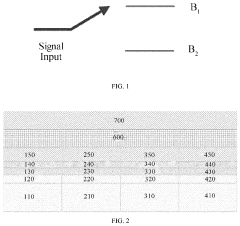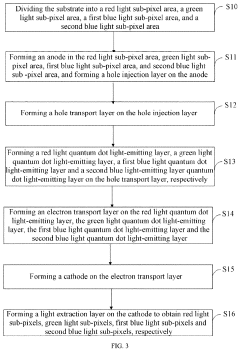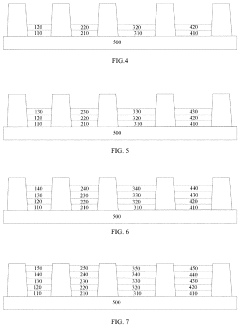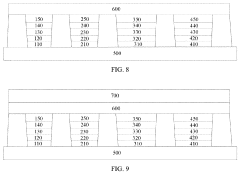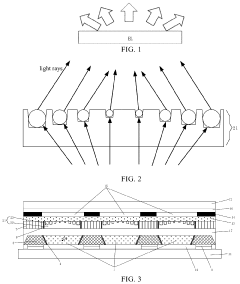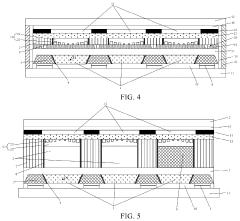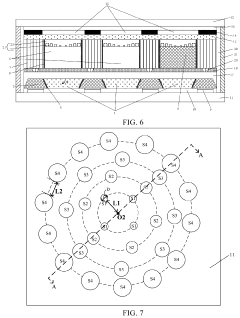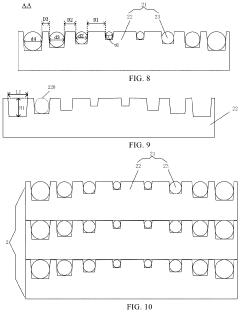How to Leverage QLED for Business Presentations?
JUN 19, 20259 MIN READ
Generate Your Research Report Instantly with AI Agent
Patsnap Eureka helps you evaluate technical feasibility & market potential.
QLED Technology Evolution and Objectives
QLED (Quantum Dot Light-Emitting Diode) technology has emerged as a revolutionary advancement in display technology, offering significant improvements in color accuracy, brightness, and energy efficiency. The evolution of QLED technology can be traced back to the early 2000s when researchers began exploring the potential of quantum dots in display applications. Since then, QLED has undergone rapid development, driven by the increasing demand for high-quality visual experiences in various sectors, including business presentations.
The primary objective of leveraging QLED for business presentations is to enhance the visual impact and effectiveness of corporate communications. By utilizing QLED displays, businesses aim to create more engaging, immersive, and persuasive presentations that can captivate audiences and convey complex information with greater clarity and precision.
QLED technology's evolution has been marked by several key milestones. Initially, the focus was on improving color gamut and brightness, which led to the development of more efficient quantum dot materials and manufacturing processes. Subsequent advancements addressed issues such as color stability, viewing angles, and power consumption, making QLED displays increasingly suitable for professional applications.
In recent years, the trend has shifted towards developing larger QLED displays with higher resolutions, such as 4K and 8K, to cater to the growing demand for expansive, detailed visuals in corporate environments. Additionally, efforts have been made to enhance the durability and longevity of QLED panels, ensuring their suitability for prolonged use in business settings.
The future objectives for QLED technology in business presentations include further improvements in energy efficiency, reduced production costs, and enhanced integration with other technologies such as touch interfaces and wireless connectivity. There is also a growing emphasis on developing flexible and modular QLED displays that can adapt to various presentation environments and formats.
As QLED technology continues to evolve, its potential applications in business presentations are expanding. From boardrooms and conference halls to trade shows and virtual meetings, QLED displays are poised to revolutionize the way companies communicate their ideas, data, and strategies. The technology's ability to render vivid colors, deep blacks, and high contrast ratios makes it particularly well-suited for displaying complex charts, graphs, and multimedia content, which are essential elements of modern business presentations.
The primary objective of leveraging QLED for business presentations is to enhance the visual impact and effectiveness of corporate communications. By utilizing QLED displays, businesses aim to create more engaging, immersive, and persuasive presentations that can captivate audiences and convey complex information with greater clarity and precision.
QLED technology's evolution has been marked by several key milestones. Initially, the focus was on improving color gamut and brightness, which led to the development of more efficient quantum dot materials and manufacturing processes. Subsequent advancements addressed issues such as color stability, viewing angles, and power consumption, making QLED displays increasingly suitable for professional applications.
In recent years, the trend has shifted towards developing larger QLED displays with higher resolutions, such as 4K and 8K, to cater to the growing demand for expansive, detailed visuals in corporate environments. Additionally, efforts have been made to enhance the durability and longevity of QLED panels, ensuring their suitability for prolonged use in business settings.
The future objectives for QLED technology in business presentations include further improvements in energy efficiency, reduced production costs, and enhanced integration with other technologies such as touch interfaces and wireless connectivity. There is also a growing emphasis on developing flexible and modular QLED displays that can adapt to various presentation environments and formats.
As QLED technology continues to evolve, its potential applications in business presentations are expanding. From boardrooms and conference halls to trade shows and virtual meetings, QLED displays are poised to revolutionize the way companies communicate their ideas, data, and strategies. The technology's ability to render vivid colors, deep blacks, and high contrast ratios makes it particularly well-suited for displaying complex charts, graphs, and multimedia content, which are essential elements of modern business presentations.
Business Presentation Market Analysis
The business presentation market has experienced significant growth in recent years, driven by the increasing importance of effective communication in corporate environments. As organizations strive to convey complex information and ideas more engagingly, there is a growing demand for advanced display technologies that can enhance the visual impact of presentations.
QLED (Quantum Dot Light-Emitting Diode) technology has emerged as a promising solution for business presentations, offering superior color accuracy, brightness, and contrast compared to traditional display technologies. The global market for QLED displays is projected to expand rapidly, with applications extending beyond consumer electronics to professional and business settings.
In the context of business presentations, QLED technology addresses several key market needs. Firstly, it provides exceptional color reproduction, allowing presenters to showcase their content with vivid and accurate colors. This is particularly valuable for industries such as design, marketing, and advertising, where color fidelity is crucial.
Secondly, QLED displays offer high brightness levels, making them suitable for well-lit conference rooms and large presentation spaces. This feature ensures that content remains visible and impactful even in challenging lighting conditions, addressing a common pain point in many business environments.
The market for QLED-enabled presentation solutions is expected to grow across various sectors, including corporate offices, educational institutions, and government agencies. As remote work and virtual meetings become more prevalent, there is an increasing demand for high-quality display technologies that can effectively convey information in both physical and digital presentation settings.
Furthermore, the integration of QLED technology with interactive features, such as touch capabilities and multi-screen connectivity, is opening up new possibilities for collaborative presentations and brainstorming sessions. This trend aligns with the growing emphasis on teamwork and interactive problem-solving in modern business environments.
As businesses increasingly recognize the importance of impactful visual communication, the adoption of QLED technology for presentations is likely to accelerate. This market growth is further supported by the ongoing miniaturization and cost reduction of QLED components, making the technology more accessible to a wider range of organizations.
In conclusion, the business presentation market shows strong potential for QLED technology adoption, driven by the need for superior visual quality, versatility, and enhanced audience engagement. As the technology continues to evolve and become more cost-effective, it is poised to play a significant role in shaping the future of business communications and presentations.
QLED (Quantum Dot Light-Emitting Diode) technology has emerged as a promising solution for business presentations, offering superior color accuracy, brightness, and contrast compared to traditional display technologies. The global market for QLED displays is projected to expand rapidly, with applications extending beyond consumer electronics to professional and business settings.
In the context of business presentations, QLED technology addresses several key market needs. Firstly, it provides exceptional color reproduction, allowing presenters to showcase their content with vivid and accurate colors. This is particularly valuable for industries such as design, marketing, and advertising, where color fidelity is crucial.
Secondly, QLED displays offer high brightness levels, making them suitable for well-lit conference rooms and large presentation spaces. This feature ensures that content remains visible and impactful even in challenging lighting conditions, addressing a common pain point in many business environments.
The market for QLED-enabled presentation solutions is expected to grow across various sectors, including corporate offices, educational institutions, and government agencies. As remote work and virtual meetings become more prevalent, there is an increasing demand for high-quality display technologies that can effectively convey information in both physical and digital presentation settings.
Furthermore, the integration of QLED technology with interactive features, such as touch capabilities and multi-screen connectivity, is opening up new possibilities for collaborative presentations and brainstorming sessions. This trend aligns with the growing emphasis on teamwork and interactive problem-solving in modern business environments.
As businesses increasingly recognize the importance of impactful visual communication, the adoption of QLED technology for presentations is likely to accelerate. This market growth is further supported by the ongoing miniaturization and cost reduction of QLED components, making the technology more accessible to a wider range of organizations.
In conclusion, the business presentation market shows strong potential for QLED technology adoption, driven by the need for superior visual quality, versatility, and enhanced audience engagement. As the technology continues to evolve and become more cost-effective, it is poised to play a significant role in shaping the future of business communications and presentations.
QLED Display Challenges in Presentations
QLED (Quantum Dot Light Emitting Diode) technology has emerged as a promising solution for business presentations, offering enhanced visual quality and energy efficiency. However, its implementation in presentation environments faces several challenges that need to be addressed for optimal performance and user experience.
One of the primary challenges is the high cost associated with QLED displays. While the technology offers superior color reproduction and brightness, the initial investment required for QLED panels can be prohibitive for many businesses, especially small to medium-sized enterprises. This cost factor often leads to a slower adoption rate in corporate settings, where budget constraints may prioritize more affordable display options.
Another significant challenge is the complexity of integrating QLED displays into existing presentation systems. Many businesses have established infrastructure for traditional projection or LCD-based setups, and transitioning to QLED technology may require substantial modifications to hardware and software configurations. This integration process can be time-consuming and may necessitate additional training for staff to effectively utilize the new technology.
The issue of color accuracy and calibration presents another hurdle for QLED displays in business presentations. While QLED technology is capable of producing a wide color gamut, ensuring consistent and accurate color representation across different devices and environments can be challenging. This is particularly crucial in business settings where brand colors and visual fidelity are of utmost importance.
Power consumption and heat management are additional concerns when implementing QLED displays for presentations. Although more energy-efficient than some alternatives, QLED panels still require significant power, especially for larger display sizes. This can lead to increased electricity costs and potential cooling requirements, which may not be feasible in all presentation spaces.
Durability and lifespan considerations also pose challenges for QLED adoption in business environments. While QLED displays generally offer good longevity, the technology is still relatively new, and long-term performance data in intensive business use scenarios is limited. Concerns about potential image retention or burn-in, especially with static presentation content, may deter some organizations from investing in QLED technology.
Lastly, the challenge of content optimization for QLED displays cannot be overlooked. To fully leverage the capabilities of QLED technology, presentation content may need to be redesigned or reformatted to take advantage of the enhanced color range and contrast. This process requires additional time and resources, potentially impacting workflow efficiency in fast-paced business environments.
One of the primary challenges is the high cost associated with QLED displays. While the technology offers superior color reproduction and brightness, the initial investment required for QLED panels can be prohibitive for many businesses, especially small to medium-sized enterprises. This cost factor often leads to a slower adoption rate in corporate settings, where budget constraints may prioritize more affordable display options.
Another significant challenge is the complexity of integrating QLED displays into existing presentation systems. Many businesses have established infrastructure for traditional projection or LCD-based setups, and transitioning to QLED technology may require substantial modifications to hardware and software configurations. This integration process can be time-consuming and may necessitate additional training for staff to effectively utilize the new technology.
The issue of color accuracy and calibration presents another hurdle for QLED displays in business presentations. While QLED technology is capable of producing a wide color gamut, ensuring consistent and accurate color representation across different devices and environments can be challenging. This is particularly crucial in business settings where brand colors and visual fidelity are of utmost importance.
Power consumption and heat management are additional concerns when implementing QLED displays for presentations. Although more energy-efficient than some alternatives, QLED panels still require significant power, especially for larger display sizes. This can lead to increased electricity costs and potential cooling requirements, which may not be feasible in all presentation spaces.
Durability and lifespan considerations also pose challenges for QLED adoption in business environments. While QLED displays generally offer good longevity, the technology is still relatively new, and long-term performance data in intensive business use scenarios is limited. Concerns about potential image retention or burn-in, especially with static presentation content, may deter some organizations from investing in QLED technology.
Lastly, the challenge of content optimization for QLED displays cannot be overlooked. To fully leverage the capabilities of QLED technology, presentation content may need to be redesigned or reformatted to take advantage of the enhanced color range and contrast. This process requires additional time and resources, potentially impacting workflow efficiency in fast-paced business environments.
Current QLED Solutions for Presentations
01 QLED structure and composition
QLED (Quantum Dot Light Emitting Diode) technology involves the use of quantum dots as light-emitting materials. The structure typically includes layers of quantum dots sandwiched between electron and hole transport layers. The composition and arrangement of these layers are crucial for optimizing the device's performance and efficiency.- QLED structure and materials: QLED (Quantum Dot Light Emitting Diode) technology involves the use of quantum dots as light-emitting materials. The structure typically includes layers of quantum dots sandwiched between electron and hole transport layers. Various materials and compositions are used to optimize the performance and efficiency of QLED devices.
- Quantum dot synthesis and preparation: The synthesis and preparation of quantum dots are crucial for QLED performance. This includes methods for controlling size, shape, and composition of quantum dots, as well as techniques for surface modification and ligand exchange to improve stability and efficiency of the quantum dots in QLED devices.
- QLED device fabrication techniques: Various fabrication techniques are employed in QLED manufacturing, including solution processing, inkjet printing, and vacuum deposition methods. These techniques aim to improve the uniformity, stability, and scalability of QLED devices for commercial applications.
- Color tuning and light management in QLEDs: Strategies for color tuning and light management in QLEDs involve optimizing the quantum dot composition, size distribution, and device structure. This includes the development of color conversion layers, light extraction techniques, and methods to improve color purity and gamut.
- QLED efficiency and lifetime improvement: Research focuses on improving the efficiency and lifetime of QLED devices. This includes developing new materials for charge transport layers, optimizing device architectures, and implementing strategies to mitigate degradation mechanisms such as photo-oxidation and thermal quenching.
02 Quantum dot synthesis and modification
The synthesis and modification of quantum dots play a vital role in QLED performance. Various methods are employed to produce quantum dots with specific properties, such as size, shape, and surface characteristics. Surface modification techniques are used to enhance stability, efficiency, and compatibility with other materials in the QLED structure.Expand Specific Solutions03 Color conversion and light management
QLED technology utilizes quantum dots for color conversion and light management. This involves optimizing the emission spectrum of quantum dots to achieve desired color output and improve color gamut. Various techniques are employed to enhance light extraction and manage light distribution within the device.Expand Specific Solutions04 QLED manufacturing processes
Manufacturing processes for QLED devices involve various techniques such as solution processing, inkjet printing, and vapor deposition. These processes are optimized to achieve uniform quantum dot layers, precise patterning, and integration with other components of the display or lighting device.Expand Specific Solutions05 QLED device optimization and performance enhancement
Ongoing research focuses on optimizing QLED device performance through various approaches. These include improving charge injection and transport, enhancing quantum dot efficiency, reducing energy loss mechanisms, and developing new materials and device architectures to achieve higher brightness, longer lifetime, and better color purity.Expand Specific Solutions
Key QLED Manufacturers and Competitors
The QLED technology for business presentations is in a growth phase, with increasing market size and adoption. The global QLED market is expanding rapidly, driven by demand for high-quality displays in corporate environments. Technologically, QLED is maturing, with key players like BOE Technology Group, TCL China Star Optoelectronics, and Samsung Display leading innovation. These companies are advancing QLED's color accuracy, brightness, and energy efficiency, making it increasingly suitable for professional presentations. Other notable contributors include Hisense Visual Technology and Huawei Technologies, further diversifying the competitive landscape. As the technology evolves, we're seeing improved integration with business software and enhanced connectivity features, positioning QLED as a promising solution for modern corporate communication needs.
BOE Technology Group Co., Ltd.
Technical Solution: BOE has developed advanced QLED technology for business presentations, focusing on high color accuracy and brightness. Their QLED displays utilize quantum dot technology to produce a wider color gamut and higher peak brightness compared to traditional LED displays. BOE's QLED panels incorporate local dimming technology for improved contrast ratios, making them ideal for detailed business presentations in various lighting conditions. The company has also integrated smart features into their QLED displays, allowing for seamless connectivity and content sharing during presentations.
Strengths: Superior color accuracy and brightness, wide viewing angles, and smart connectivity features. Weaknesses: Higher cost compared to traditional LED displays, potential for image retention with static content.
TCL China Star Optoelectronics Technology Co., Ltd.
Technical Solution: TCL CSOT has developed QLED technology specifically tailored for business presentations. Their approach focuses on creating large-format QLED displays with high resolution and color accuracy. TCL CSOT's QLED panels utilize advanced quantum dot technology to achieve a wider color gamut and higher peak brightness, ensuring that presentation content is vivid and easily visible even in brightly lit rooms. The company has also implemented anti-glare coatings and wide viewing angle technology to enhance the viewing experience for all participants in a presentation setting.
Strengths: Large-format displays suitable for conference rooms, high color accuracy, and anti-glare technology. Weaknesses: Potentially higher power consumption compared to traditional LED displays.
QLED Innovations for Business Use
Display device and pixel lighting control method therefor
PatentPendingUS20240013710A1
Innovation
- A display device comprising a plurality of pixels, each including a red light sub-pixel, a green light sub-pixel, a first blue light sub-pixel, and a second blue light sub-pixel, where the first blue light sub-pixel is configured to emit light at high brightness and the second blue light sub-pixel is configured to emit light at low brightness, with the first blue light sub-pixel having high efficiency and the second blue light sub-pixel having a long lifetime, allowing for independent control based on brightness requirements.
Display panel and producing method thereof, and display device
PatentPendingUS20240224736A1
Innovation
- A display panel design featuring light emitting units with scattering components, where scattering particles are arranged in a matrix with particle sizes and distances correlated to increase light output, and refractive indexes varying along the light exiting direction to converge light rays, combined with quantum-dot luminescent layers and color converting units for improved light emission.
Cost-Benefit Analysis of QLED in Business
When considering the implementation of QLED technology for business presentations, a thorough cost-benefit analysis is crucial. The initial investment in QLED displays can be substantial, with high-end models costing significantly more than traditional LCD or LED alternatives. However, the long-term benefits often outweigh the upfront costs.
QLED technology offers superior image quality, with vibrant colors, deep blacks, and high contrast ratios. This enhanced visual experience can greatly improve the impact of business presentations, making complex data more accessible and engaging. The improved clarity and color accuracy can lead to better audience retention and understanding of presented information, potentially resulting in more successful business outcomes.
Energy efficiency is another key factor in the cost-benefit equation. QLED displays typically consume less power than their LCD counterparts, especially when displaying darker content. Over time, this can lead to significant savings on electricity costs, particularly for businesses that frequently use presentation displays.
Durability and longevity also contribute to the overall value proposition of QLED technology. These displays are less prone to image retention or burn-in compared to OLED alternatives, ensuring consistent performance over extended periods. This durability translates to lower replacement and maintenance costs in the long run.
The versatility of QLED displays adds another dimension to their value. Many models offer features like multi-view capabilities, allowing for simultaneous display of multiple content sources. This functionality can enhance collaborative work environments and streamline presentation processes, potentially improving productivity and reducing the need for additional display hardware.
However, it's important to consider the specific needs and scale of the business. Smaller organizations with limited presentation requirements may find it challenging to justify the higher initial costs. Conversely, larger corporations or those heavily reliant on visual presentations may see substantial returns on their investment through improved communication effectiveness and operational efficiencies.
In conclusion, while the upfront costs of QLED technology for business presentations are significant, the long-term benefits in terms of visual quality, energy efficiency, durability, and versatility can provide substantial value. Organizations should carefully evaluate their specific needs, usage patterns, and budget constraints to determine if the investment in QLED technology aligns with their overall business objectives and financial strategies.
QLED technology offers superior image quality, with vibrant colors, deep blacks, and high contrast ratios. This enhanced visual experience can greatly improve the impact of business presentations, making complex data more accessible and engaging. The improved clarity and color accuracy can lead to better audience retention and understanding of presented information, potentially resulting in more successful business outcomes.
Energy efficiency is another key factor in the cost-benefit equation. QLED displays typically consume less power than their LCD counterparts, especially when displaying darker content. Over time, this can lead to significant savings on electricity costs, particularly for businesses that frequently use presentation displays.
Durability and longevity also contribute to the overall value proposition of QLED technology. These displays are less prone to image retention or burn-in compared to OLED alternatives, ensuring consistent performance over extended periods. This durability translates to lower replacement and maintenance costs in the long run.
The versatility of QLED displays adds another dimension to their value. Many models offer features like multi-view capabilities, allowing for simultaneous display of multiple content sources. This functionality can enhance collaborative work environments and streamline presentation processes, potentially improving productivity and reducing the need for additional display hardware.
However, it's important to consider the specific needs and scale of the business. Smaller organizations with limited presentation requirements may find it challenging to justify the higher initial costs. Conversely, larger corporations or those heavily reliant on visual presentations may see substantial returns on their investment through improved communication effectiveness and operational efficiencies.
In conclusion, while the upfront costs of QLED technology for business presentations are significant, the long-term benefits in terms of visual quality, energy efficiency, durability, and versatility can provide substantial value. Organizations should carefully evaluate their specific needs, usage patterns, and budget constraints to determine if the investment in QLED technology aligns with their overall business objectives and financial strategies.
Environmental Impact of QLED Technology
The environmental impact of QLED technology in business presentations is an important consideration as organizations strive for sustainability. QLED displays offer several advantages over traditional LCD and OLED technologies in terms of energy efficiency and longevity, which contribute to reduced environmental footprint.
QLED screens consume less power compared to conventional displays, particularly when displaying bright content. This energy efficiency translates to lower electricity consumption over the lifetime of the device, reducing carbon emissions associated with power generation. The improved energy efficiency is especially beneficial for businesses that frequently use presentations, as it can lead to significant cost savings and reduced environmental impact over time.
The longevity of QLED displays is another factor that contributes to their positive environmental impact. These screens typically have a longer lifespan compared to other display technologies, which means they need to be replaced less frequently. This reduced turnover rate results in less electronic waste generation, alleviating the burden on landfills and recycling facilities.
QLED technology also utilizes fewer harmful materials in its production process compared to some other display technologies. For instance, QLED screens do not require the use of organic compounds that can be found in OLED displays, which can be challenging to recycle and dispose of safely. This aspect of QLED technology aligns with the growing emphasis on reducing hazardous substances in electronic products.
The manufacturing process of QLED displays has been optimized over time, leading to more efficient production methods that require less energy and generate less waste. Many manufacturers have implemented sustainable practices in their QLED production lines, such as using recycled materials and implementing closed-loop recycling systems for certain components.
When considering the end-of-life phase, QLED displays offer advantages in terms of recyclability. The materials used in QLED screens, particularly the quantum dots, can be more easily separated and recovered compared to some other display technologies. This facilitates more effective recycling processes, potentially reducing the environmental impact associated with electronic waste disposal.
However, it is important to note that the overall environmental impact of QLED technology in business presentations also depends on factors such as usage patterns, maintenance practices, and proper disposal at the end of the product's life cycle. Organizations implementing QLED displays for presentations should consider adopting energy-saving settings, proper maintenance to extend device lifespan, and responsible recycling practices to maximize the environmental benefits of this technology.
QLED screens consume less power compared to conventional displays, particularly when displaying bright content. This energy efficiency translates to lower electricity consumption over the lifetime of the device, reducing carbon emissions associated with power generation. The improved energy efficiency is especially beneficial for businesses that frequently use presentations, as it can lead to significant cost savings and reduced environmental impact over time.
The longevity of QLED displays is another factor that contributes to their positive environmental impact. These screens typically have a longer lifespan compared to other display technologies, which means they need to be replaced less frequently. This reduced turnover rate results in less electronic waste generation, alleviating the burden on landfills and recycling facilities.
QLED technology also utilizes fewer harmful materials in its production process compared to some other display technologies. For instance, QLED screens do not require the use of organic compounds that can be found in OLED displays, which can be challenging to recycle and dispose of safely. This aspect of QLED technology aligns with the growing emphasis on reducing hazardous substances in electronic products.
The manufacturing process of QLED displays has been optimized over time, leading to more efficient production methods that require less energy and generate less waste. Many manufacturers have implemented sustainable practices in their QLED production lines, such as using recycled materials and implementing closed-loop recycling systems for certain components.
When considering the end-of-life phase, QLED displays offer advantages in terms of recyclability. The materials used in QLED screens, particularly the quantum dots, can be more easily separated and recovered compared to some other display technologies. This facilitates more effective recycling processes, potentially reducing the environmental impact associated with electronic waste disposal.
However, it is important to note that the overall environmental impact of QLED technology in business presentations also depends on factors such as usage patterns, maintenance practices, and proper disposal at the end of the product's life cycle. Organizations implementing QLED displays for presentations should consider adopting energy-saving settings, proper maintenance to extend device lifespan, and responsible recycling practices to maximize the environmental benefits of this technology.
Unlock deeper insights with Patsnap Eureka Quick Research — get a full tech report to explore trends and direct your research. Try now!
Generate Your Research Report Instantly with AI Agent
Supercharge your innovation with Patsnap Eureka AI Agent Platform!
